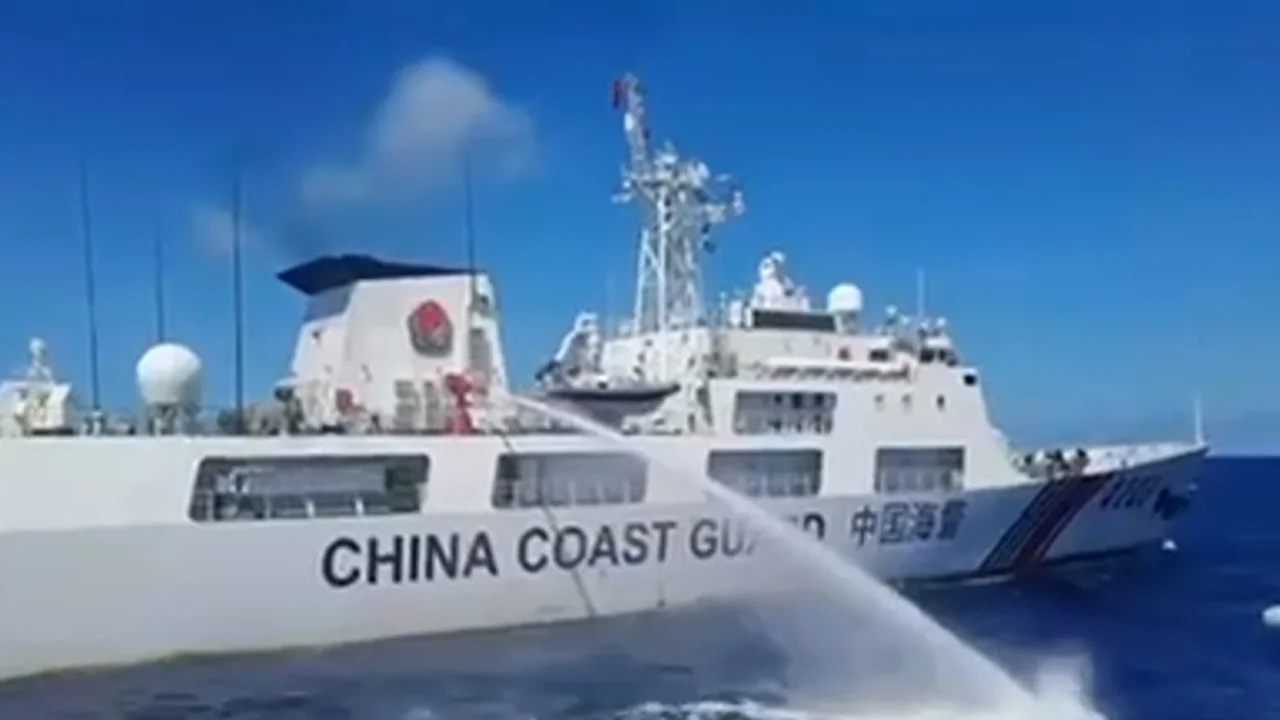The incident, which analysts say intensifies an already tense situation and may prompt the United States and its allies to move more quickly on plans for joint patrols in the waterway, has caused China to face growing international backlash. On Saturday, one of China’s coast guard vessels fired a water cannon at a Philippine boat in the South China Sea.
The Second Thomas Shoal, a South China Sea feature in Manila’s exclusive economic zone that China calls Renai Reef and also claims as its sovereign territory, was the subject of video from the Philippines showing a large Chinese Coast Guard ship spraying a much smaller Philippine boat that was attempting to deliver supplies to a garrison of Philippine marines there.
The Chinese ship was also visible in images from the Philippine Coast Guard, which was escorting the resupply boats, getting perilously close to them.
A statement from the Philippine Coast Guard was posted on its official Facebook page on Saturday. “The Philippine Coast Guard (PCG) strongly condemns the China Coast Guard’s (CCG) dangerous manoeuvres and illegal use of water cannons against PCG vessels,” the statement read.
By Sunday, Washington, Manila’s principal ally, had denounced China’s actions and reaffirmed that it will uphold its end of the mutual defence pact with the Philippines.
According to a statement from the US State Department’s Matthew Miller, “The United States reaffirms an armed attack on Philippine public vessels, aircraft, and armed forces in the South China Sea would invoke US mutual defence commitments under Article IV of the 1951 US Philippines Mutual Defence Treaty.”
Allies of the US formed a unified front with Manila and Washington.
Australian, Japanese, and German officials referred to China’s moves as “dangerous” and “destabilising.”
The Canadian Embassy in Manila also stated that Ottawa “unreservedly condemns the dangerous and provocative actions taken by the Chinese Coast Guard.”
Tension between Manila and Beijing has always been centred on the South China Sea.
Beijing asserts “indisputable sovereignty” over the majority of the islands in the 1.3 million square mile South China Sea, even those hundreds of miles from the Chinese mainland.
This includes the Spratlys, also known as the Nanshas in Beijing, a group of 100 tiny islands and reefs that are also fully or partially claimed by the Philippines, Malaysia, Brunei, and Taiwan.
However, Manila refers to the region as the West Philippine Sea. It purposefully grounded the BRP Sierra Madre, a navy transport ship manned by Filipino troops, on Second Thomas Shoal in 1999 to bolster its territorial claims.
The international Permanent Court of Arbitration in the Hague, which determined in 2016 that China lacks a legal foundation to assert historic rights to the majority of the South China Sea, supports Manila’s claims.
Beijing has disregarded the decision.
Analysts and lawmakers in the Philippines described the incident on Saturday as an improvement over a number of Chinese-Philippine conflicts this year, which included a Chinese ship firing a laser at a Philippine vessel in February and a succession of what analyst Collin Koh called “near collisions.”
According to Koh, research fellow at the S. Rajaratnam School of International Studies in Singapore, “This most recent incident clearly represents an escalation.”
Sen. Alan Peter Cayetano of the Philippines told CNN affiliate CNN Philippines, “I really believe we’re entering the period of brinkmanship diplomacy.”
He warned that if something went wrong, the area may become unstable.
However, China doesn’t appear to be rethinking its assertions.
According to a statement posted on the China Coast Guard’s website on Sunday, “two Filipino supply vessels and two coast guard vessels illegally intruded into the waters adjacent to Renai Reef in China’s Nansha Islands.”
Gan reaffirmed Chinese territorial claims to the islands in the South China Sea and promised to keep up with regional law enforcement efforts.
Beijing could be expected to continue what he called its “grey zone” tactics, which he defined as actions that fall just short of using force and thus invoking the US-Philippine mutual defence treaty, according to Jeffrey Ordaniel, director of maritime security at the Pacific Forum and assistant professor at Tokyo International University.
The international condemnation of Beijing, according to Blake Herzinger, a research fellow at the United States Studies Centre in Australia, is positive, but Manila needs to do more than just gather evidence to support its assertions.
The Philippines would need to develop a more comprehensive strategy to combine action with its diplomatic campaign since “diplomatic response will not stop this kind of maritime aggression,” the official added.
According to Koh, this might result in the US and the Philippines moving more quickly towards their plans for joint patrols in the South China Sea, something that both the US Defence Secretary Lloyd Austin and his Philippine counterpart Gilberto Teodoro Jr. predicted would happen in the future when they spoke last month.
Australia and Japan, according to reports, may join the US, Philippines, and Australia on patrols.
Koh asserted that for Washington to deter Beijing, more than words will be required.
The US will “need to be seen to walk the talk and not give the impression that Beijing continues to escalate its actions without consequences,” Koh added.
Ornaiel concurred.
The Americans “have a choice to make,” he said.
Beijing will continue to be successful in altering the status quo if US responses are restricted to rhetoric and possibly military drills.

